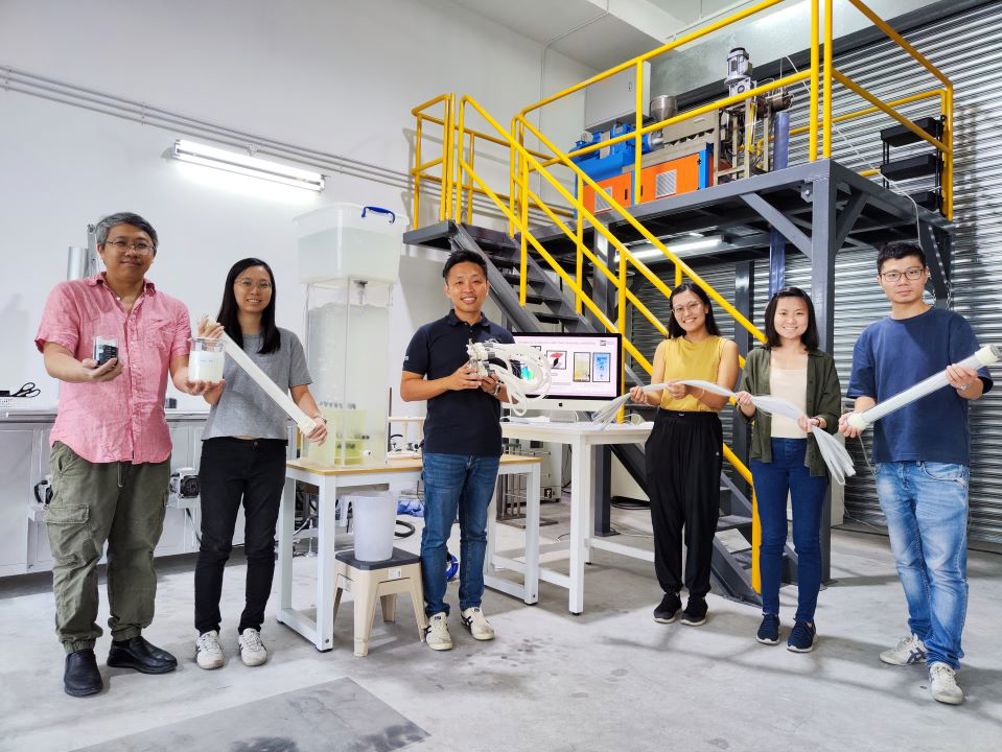The new system also has only half the carbon footprint of conventional water treatment plants through an efficient nanocomposite membrane called Clarity.
Clarity is made from special nanoparticles combined with low-cost polymers such as polypropylene (PP), commonly used for plastic grocery bags. It is easier and more environmentally friendly to manufacture than the conventional polyvinylidene fluoride (PVDF) membranes used by developed countries.
With a new nanocomposite structure developed by NTU School of Materials Science and Engineering Professor Hu Xiao and the Atera Water team, Clarity is estimated to be 2–3 times stronger than other PP membranes on the market.
SIT and Atera Water have incorporated Clarity membranes into a water treatment system named TeraStream, which takes advantage of the increased robustness and lower cost.
Incorporating cutting-edge fluid dynamic modelling, Assistant Professor Elisa Ang, Associate Professor Victor Wang, Associate Professor An Hui, and Dr Peter Beshay from SIT’s Engineering Cluster worked with Atera Water closely to design TeraStream, enabling it to handle the challenging environments found in developing countries.
TeraStream aims to replace the rudimentary sand filter systems used in many regional countries such as Vietnam and Indonesia, says Atera Water CEO and Co-founder Dr Adrian Yeo, an NTU alumnus.
“These sand filters which used to work for the last century are now unable to purify the increasingly polluted water in the ground and rivers in many countries, due to reasons such as over-exploitation of water resources, climate change and pollution from industries,” explained Dr Yeo.
TeraStream was piloted in Vietnam from March to August 2023 and will now be deployed in a 10,000m3/day water treatment facility in Ha Tinh Province in northeastern Vietnam. The amount of clean drinking water generated daily is the equivalent of four Olympic-sized swimming pools (50m x 25m x 2m).
Every facet of the TeraStream was designed with sustainability in mind.
“Prior to the establishment of Atera Water, when Dr Adrian Yeo approached me looking for a solution that can enhance the strength of polymeric membranes, I was excited about the potential where our materials science knowledge can be used to tackle one of humanity’s greatest challenges, which is providing access to clean and affordable drinking water – also one of United Nation’s Sustainable Development Goals,” said Prof Hu, Programme Director of Sustainable Chemistry & Materials at NTU’s Nanyang Environment & Water Research Institute (NEWRI). “The initial patents on the jointly developed technology were filed quickly, thanks to the strong technical know-how at NTU and pressing demand from the industry.”
Clarity membranes are made using a unique melt-stretching method requiring zero harsh chemicals. The PP polymer and nanoparticle compounds are combined during the process to make a straw-like hollow fibre structure that has a slit-like pore structure. Despite allowing water to pass through faster, the slits can still block up to 99.99% of solid contaminants and microorganisms.
These nanoparticle compounds were specially selected with help from Prof Hu, who has pioneered sustainable ways to create new composite and hybrid materials.
“To achieve sustainable clean water production, it is crucial to design a system that features a good flow of water and efficient use of energy,” said Asst Prof Ang, who led the SIT team.
“Our partnership with Atera Water represents the integration of translational research and real-world impact. At SIT, we have harnessed our applied research expertise to tackle the pressing challenges surrounding sustainable water production and achieved an outcome with the potential to forge a more sustainable and meaningful future in clean water production. This project also gives our students the opportunity to understand and participate in solving a real-world challenge,” said Asst Prof Ang.
By carefully controlling the water flow – also known as hydrodynamics – within the system, TeraStream is able to operate at a low and stable water pressure, which can reduce chemical and electrical consumption by up to 90% versus conventional systems. It also generates no sludge, which could potentially save up to 3,000 tons of carbon annually.

In comparison, conventional PVDF membrane systems are designed to operate at a higher water pressure, thus consuming significant amounts of electricity and chemicals to maintain. It requires frequent cleaning to remove contaminants, which forms waste sludge that needs to be treated and landfilled.
Additionally, the production of PVDF hollow-fibre membranes generates a large amount of waste chemical pollutants, which also need to be treated further before they can be discharged, resulting in a larger environmental impact and carbon footprint.
As a made-in-Singapore product, TeraStream will be manufactured in Atera Water’s facility in Jurong and will be exported globally.







